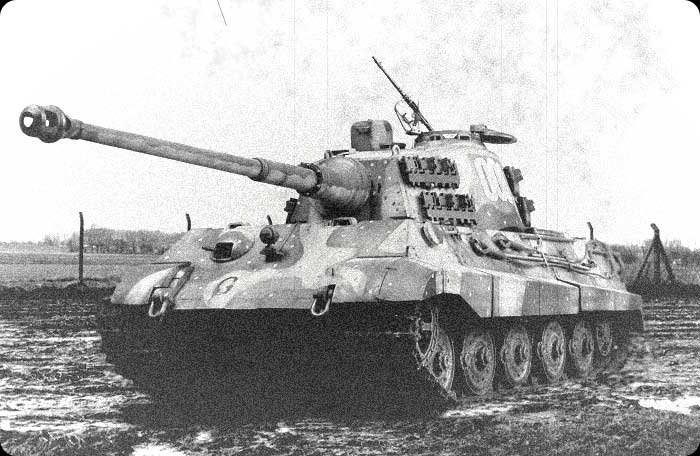Quoted Text
Hi everyone, newbie to the site here, & I'm hoping someone can help me with a couple of questions regarding the Tiger B.
I am about to start a project using Dragons "King Tiger c/w Zimmerit" Kit no. 6303.
I would like to set it either in the battle of the Ardennes, or mabe in Normandy 44'.
As I am new to "Accurate modelling" I could really use advice on as much as possible eg. Track type, Track Hangers etc...etc... But my first question is regarding track guards & anti-grenade mesh.
Did the track guards differ at all through the war, or were they pretty much standard? I know that some crews removed them altogether when going into combat, & that some got damaged/lost through the life of the tank.
As for the anti-grenade mesh. Did that remain the same? Were they only used from a specific date etc...?
Any help anyone can give me would be greatly appreciated.
Thanks. 
Actually, the side skirts were removed when the vehicle was transported by rail. The wide battle tracks had to be switched to narrow transportation tracks, so the tanks could be loaded onto railway flat cars. The skirts were removed at the same time for the same reason. Otherwise, the tanks would risk striking oncoming trains on opposing tracks. The procedure had to be reversed upon arrival at the destination.
The skirts were sometimes lost during this process, particularly if the unit had to rush from the railhead directly into action. Unlike the Tiger I (Tiger Ausf. E), the King Tiger's skirts were thin armor plate, intended to degrade the performance of Soviet antitank rifles. They might also have had some standoff value against hollow charge bazooka or PIAT projectiles.
The design remained much the same throughout production. At the very end, in March, 1945, a reinforcing rib was added to the curved front mudguard, where it attached to the curved outer skirt part (which was removable). Academy's recent King Tiger depicts one of these tanks. It also has transportation tracks, as supplies of battle tracks had been interrupted by the war situation. This kit is also offered by Eduard.
The raised mesh sections under the turret overhang were there to prevent satchel charges from being inserted between the turret bustle and the engine deck. The original, so-called Porsche turret required a larger metal frame for the mesh. The later, production turret (the so-called Henschel type), had a smaller frame, and it remained the same throughout production.
For Normandy, July-August, 1944, you could depict the first or third company of the Army's 503rd battalion. By historical accident, this was the most-photographed King Tiger unit of all. Only one or two tanks in each company had the new turret, though.
The battalion was re-equipped with 45 new King Tigers in September, most of which had Zimmerit, and the unit was rushed to Hungary in October, spending the rest of the war in the east.
For the Ardennes, you'd have to do a tank from the Army 506th battalion, about two-thirds of which was equipped with tanks with Zimmerit coating (the SS 501st battalion was equipped entirely with newer tanks without Zimmerit). Unfortunately, photos of the 506th are few and far between.


















